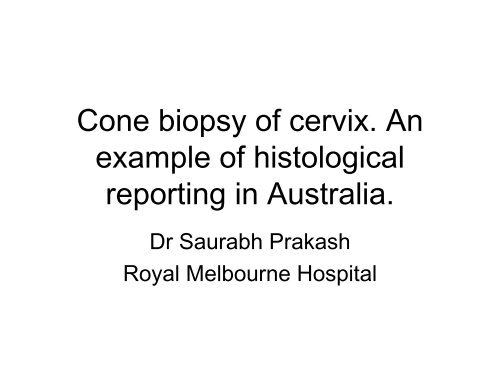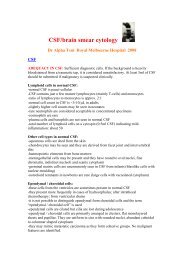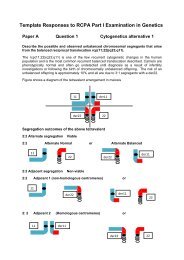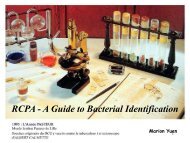Cone biopsy of cervix - Rcpa.tv
Cone biopsy of cervix - Rcpa.tv
Cone biopsy of cervix - Rcpa.tv
You also want an ePaper? Increase the reach of your titles
YUMPU automatically turns print PDFs into web optimized ePapers that Google loves.
<strong>Cone</strong> <strong>biopsy</strong> <strong>of</strong> <strong>cervix</strong>. An<br />
example <strong>of</strong> histological<br />
reporting in Australia.<br />
Dr Saurabh Prakash<br />
Royal Melbourne Hospital
Indications for cone <strong>biopsy</strong><br />
• Persisting low grade squamous<br />
dysplasia<br />
• High grade squamous dysplasia<br />
• Microinvasive carcinoma<br />
• Adenocarcinoma in-situ (ACIS)
Terminology<br />
• Cervical intraepithelial neoplasia (CIN)<br />
• Squamous dysplasia assessed as mild<br />
(CIN I), moderate (CIN II) or severe<br />
(CIN III)<br />
• Low grade squamous intraepithelial<br />
lesion (LGSIL) = HPV effect or CIN I<br />
• High grade squamous intraepithelial<br />
lesion (HGSIL) = CIN II or CIN III
Terminology<br />
• Glandular dysplasia (ACIS) assessed<br />
as being present or absent<br />
• Microinvasive carcinoma defined<br />
(FIGO) as maximal depth <strong>of</strong> stromal<br />
invasion <strong>of</strong> less than 1mm, and, with<br />
absent lymphovascular space invasion.<br />
The entire lesion should be examined<br />
histologically.
Contents <strong>of</strong> histology report<br />
• Patient details (name, date <strong>of</strong> birth)<br />
• Clinical information<br />
• Macroscopic description<br />
• Microscopic description including<br />
ancillary tests<br />
• Diagnosis.
Macroscopic description<br />
1. Measure the specimen in three<br />
dimensions (mm).<br />
2. Make note <strong>of</strong> orientating sutures which<br />
are usually attached.<br />
3. Place specimen in front <strong>of</strong> you, with<br />
orientating suture (usually indicating<br />
anterior) at 12 o’clock position.
Macroscopic description<br />
4. Ink 12 o’clock half <strong>of</strong> specimen<br />
(anterior) one colour and 6 o’clock half<br />
(posterior) another colour.<br />
5. Serial sagittal sections (in 12-6 o’clock<br />
plane) taken, commencing at 3 o’clock<br />
end <strong>of</strong> specimen and continuing to 9<br />
o’clock end.<br />
6. Submit entire specimen for histology in<br />
sequential blocks.
Orientation <strong>of</strong> specimen<br />
Suture = anterior or 12 o’clock<br />
A portion <strong>of</strong> <strong>cervix</strong>, 14x25x10mm, with an attached<br />
suture indicating anterior. The mucosa is smooth.
Mark margins<br />
The anterior half <strong>of</strong> the specimen is marked black and the<br />
posterior half is marked green.
Take sagittal sections <strong>of</strong><br />
specimen.<br />
Commence sectioning at 3 o’clock and continue<br />
to 9 o’clock end <strong>of</strong> specimen.
Sagittal sections for<br />
processing.<br />
1 2 3 4 5
Microscopic description<br />
1. Three levels should be taken <strong>of</strong> each<br />
block.<br />
2. State tissue type (<strong>cervix</strong>) and included<br />
mucosa (squamous and glandular<br />
epithelium).<br />
3. Is transformation zone (squamocolumnar<br />
junction) included?
Microscopic description<br />
4. Assess both squamous and glandular<br />
mucosa, particularly for dysplasia or<br />
reactive changes.<br />
5. Assess stroma for invasion or benign<br />
features such as inflammation.<br />
6. If dysplasia or invasive tumour is<br />
present, state margins <strong>of</strong> excision.
Cervical squamous dysplasia<br />
• Dysplastic cells are crowded, show<br />
nuclear enlargement and<br />
hyperchromasia with coarse chromatin<br />
• There are increased numbers <strong>of</strong><br />
suprabasilar mitoses<br />
• Atypical koilocytes and dyskeratoses<br />
are seen in Human Papilloma Virus<br />
infection (HPV)
Cervical squamous dysplasia<br />
• CIN I - changes confined to lower<br />
(basal) third <strong>of</strong> epithelium<br />
• CIN II - changes confined to lower twothirds<br />
<strong>of</strong> epithelium<br />
• CIN III - changes involved full thickness<br />
<strong>of</strong> epithelium
Adenocarcinoma in-situ<br />
• Crowded glands in which there are<br />
columnar cells showing nuclear<br />
hyperchromasia, elongation and<br />
enlargement.<br />
• The basement membrane is intact.<br />
• Nuclear features may resemble those<br />
seen in nuclei <strong>of</strong> dysplastic adenomas<br />
in colon.
Microscopic description<br />
Transformation zone<br />
at low power<br />
Transformation zone
Microscopic description<br />
• Squamous epithelium<br />
shows crowding and<br />
nuclear atypia<br />
• Koilocytes are present<br />
• Lower third <strong>of</strong><br />
epithelium involved =<br />
CIN I (low grade<br />
dysplasia)
Microscopic description<br />
• Squamous epithelium<br />
shows crowding,<br />
nuclear atypia with<br />
scattered mitoses<br />
• Entire thickness <strong>of</strong><br />
epithelium involved =<br />
CIN III (high grade<br />
dysplasia)<br />
mitosis
Microscopic description<br />
• No stromal invasion is<br />
present<br />
• No glandular dysplasia<br />
is identified<br />
• Note chronic stromal<br />
inflammation<br />
mitosis
Microscopic description<br />
• Must also assess for presence <strong>of</strong><br />
stromal invasion<br />
• Comment on margins <strong>of</strong> excision if<br />
dysplasia is present - measure in<br />
millimetres from endocervical or<br />
ectocervical margin.
Immunoperoxidase stains<br />
• Can be useful in some contexts (eg CIN<br />
III Vs immature squamous metaplasia)<br />
• P16 positivity indicates integration <strong>of</strong><br />
high risk HPV virus<br />
• Positive defined as cytoplasmic and<br />
nuclear staining <strong>of</strong> full thickness <strong>of</strong><br />
epithelium. Basal staining may be seen<br />
but may not be significant.
P16 immunostain<br />
• Nuclear and<br />
cytoplasmic staining <strong>of</strong><br />
full thickness <strong>of</strong> the<br />
squamous epithelium<br />
• Endocervical glands<br />
are negative<br />
• Non-dysplastic<br />
epithelium is negative.
Immunoperoxidase stains<br />
• Ki67 (MIB1) immunostain is a<br />
proliferation marker<br />
• Positive defined as nuclear staining <strong>of</strong><br />
any degree<br />
• CIN shows positive staining<br />
suprabasilar squamous cells
Ki67 immunostain<br />
• Positive cells in all<br />
parts <strong>of</strong> the squamous<br />
epithelium<br />
• Non-dysplastic<br />
epithelium shows<br />
scattered isolated cells<br />
in only the basal<br />
layers.
Example <strong>of</strong> histopathology<br />
report
References<br />
• The Bethesda system for reporting<br />
gynaecological cytology. Definitions, criteria<br />
and reporting notes. 2nd eg. Solomon et al.<br />
2005.<br />
• Screening to prevent cervical cancer.<br />
Guidelines for management <strong>of</strong> asymptomatic<br />
women with screen detected abnormalities.<br />
NHMRC. Australian Government. 2005.<br />
• Pathology and Genetics Tumours <strong>of</strong> the<br />
Breast and Female Genital Organs. WHO<br />
classification <strong>of</strong> tumours. Tavassoli et al.<br />
2003.
















